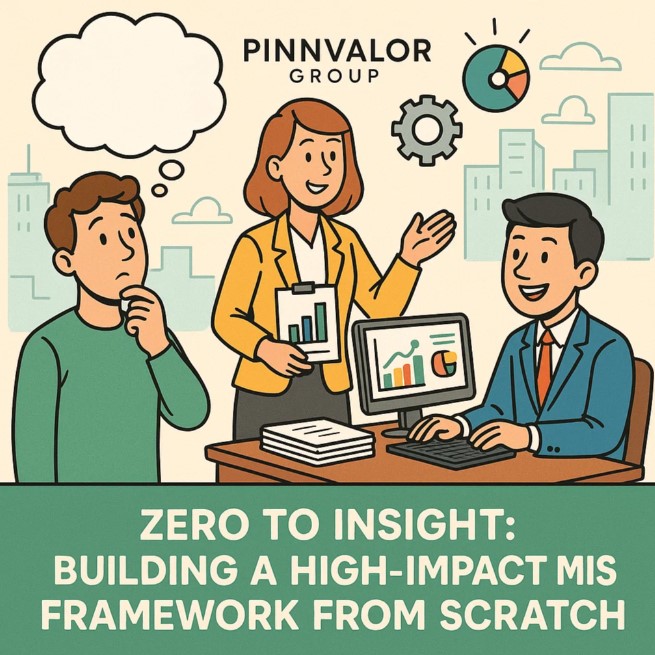
Zero to Insight: Building a High-Impact MIS Framework from Scratch
In a world flooded with data but starved for actionable insight, an effective Management Information System (MIS) is no longer a luxury—it’s a necessity. Whether you're a startup founder, a growing enterprise, or a transformation-focused CFO, building a high-impact MIS framework from scratch can unlock smarter decisions, faster responses, and sharper competitive advantage.
In this blog, we take you on a step-by-step journey to design and implement an MIS framework that doesn’t just track data—it transforms it into insight.
Is your business running on data—or just drowning in it?
Your MIS should do more than track data—it should transform it into insight. With the right framework, data becomes your greatest competitive advantage.
🔍 What is an MIS Framework?
A Management Information System (MIS) framework is the structured architecture of people, processes, and technology that collects, processes, and delivers business-critical information to decision-makers. It combines data sources, analytical tools, reporting mechanisms, and governance models into one cohesive system.
🚀 Why Build It from Scratch?
While off-the-shelf tools exist, many businesses find them inflexible, overloaded with irrelevant features, or misaligned with their strategic goals. A custom MIS framework:
- Aligns directly with your KPIs and strategic objectives
- Integrates smoothly with existing workflows and tools
- Scales with your business needs
- Enhances data ownership and control
🧱 The Building Blocks of a High-Impact MIS Framework
1. Define the Vision and Objectives
Start by answering:
- What are the decisions the MIS should support?
- What kind of reports and analytics are needed by leadership, managers, and frontline teams?
- Which KPIs will drive insight and performance?
Tip: Keep stakeholders involved early—especially department heads who’ll be using the system daily.
2. Map the Data Ecosystem
Identify all internal and external data sources:
- ERP systems, CRMs, accounting software
- Market intelligence, customer feedback, operational logs
- Manual inputs (where automation is not yet feasible)
Create a data inventory and assess each source for:
- Accuracy
- Frequency of updates
- Format compatibility
3. Design the Architecture
This is your MIS blueprint. It should include:
- Data capture layer (where and how data is collected)
- Data processing and storage layer (ETL pipelines, databases)
- Analytics and insight layer (dashboards, models, reports)
- User access and security controls
Cloud-based architecture (like AWS, Azure, or GCP) is often preferable for scalability and integration flexibility.
4. Select Tools and Technologies
Choose tools based on:
- Size of the organization
- Data volume and complexity
- User technical proficiency
Examples:
- Data warehousing: Snowflake, BigQuery, or PostgreSQL
- ETL tools: Talend, Apache NiFi, Microsoft Power Automate
- BI platforms: Power BI, Tableau, Looker, or Zoho Analytics

5. Establish Data Governance
A high-impact MIS thrives on trustworthy data. Set up:
- Data validation protocols
- Access controls and role-based permissions
- Documentation standards
- Policies for privacy, compliance, and version control
Tip: Assign a data steward or MIS champion to oversee integrity and drive adoption.
6. Build for the End User
The ultimate success of your MIS depends on usability. Focus on:
- Customizable dashboards
- Role-specific views (finance, marketing, operations, etc.)
- Drill-down capabilities and data interactivity
- Mobile accessibility
A user-centric design ensures higher engagement and quicker decision-making.
7. Pilot, Test, and Iterate
Roll out a minimum viable system to a single department or function first. Gather feedback, resolve glitches, and gradually scale.
Test for:
- Latency and data refresh speed
- Report accuracy
- User comprehension and satisfaction
8. Train and Drive Adoption
Even the best MIS fails without buy-in. Run training sessions tailored to each department’s use cases. Share quick wins and success stories to fuel enthusiasm.
Adoption accelerates when users see the MIS solving real business problems.
🌟 From Zero to Insight: Measuring Impact
After implementation, measure the ROI of your MIS by tracking:
- Decision-making turnaround time
- Increase in data-driven decisions
- Reduction in manual reporting
- Alignment of actions with strategic KPIs
💡 Final Thoughts
Building an MIS framework from scratch is not just a technical exercise—it’s a strategic transformation. When done right, it becomes the central nervous system of your business, sensing opportunities, diagnosing risks, and empowering every decision with data-backed clarity.
